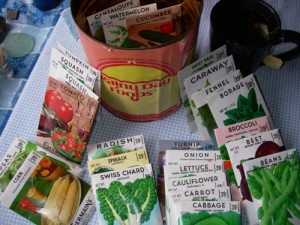When we bought our property, the previous owners left behind many interesting things. Some of them were obviously not worth packing out the trail, but most of the items have proved useful in some way. The most useful, of course, is the pantry half full of canning jars, sealed buckets of hard red wheat, and #10 cans of dehydrated foods from Rainy Day Foods. I researched the shelf life of dehydrated foods and found great information on a Website called Survival Acres (now called Food Assets). There I learned that seeds/food stored in airtight containers at 50° or less can be good for 30 years or more. I can attest that all the products we have opened have been at least palatable.
One can I opened in January was a “Survival Garden Pak” that claimed it “contains enough seeds for both a fall and spring garden.” I had been looking over my garden plan and was checking the seeds I needed to order, when I remembered seeing two of these cans in the storage shed. I decided to see if the seeds were viable before making my seed order.
What I found inside was a veritable time capsule. The packets indicated the seeds were packed for the growing seasons of 1977 and 1978. The pictures were mostly drawn, rather than photographs and each was clearly marked with a price of 39¢. It was so cool!
Germain’s Seed Company of California, the supplier of the seeds, had been in operation since 1871. It appears Germain’s is still around but does not have a direct Website. They may just do commercial seed.
The following seeds were included: pole bean, beet, broccoli, corn, cabbage, cantaloupe, carrot, cauliflower, cucumber, lettuce, onion, pea, pumpkin, radish, Swiss chard, spinach, Hubbard squash, tomato, turnip, watermelon, and zucchini as well as borage, basil, caraway and fennel. The fairly standard varieties did not indicate whether they were hybrids or open pollinated. Some Web research found that genetic modifications did not begin until later years. So no worries there.

My seed time capsule.
I wonder if the any of the varieties are ones that have “died out” and therefore will be revived this way? I should contact seed banks to see if they would like some of the varieties that I can’t grow here. I’m not even going to open the corn packet. I may try the cantaloupe and watermelon in the greenhouse, if there is room.
Speaking of whom to share this with, I plan to tell the local garden blog and Mike McGrath at You Bet Your Garden. The people we bought the land from might be interested in how this turns out too.
These seeds were packaged when I was in high school. The older ones were prepared for the summer when my brother and I went to Europe with a student tour group. I remember my grandfather’s garden in eastern Washington later that summer. Awesome corn and tomatoes! I wonder if he used any of these varieties? I loved his garden there at the bottom of a long sloping lawn at the edge of a reed marsh that became Lake Osoyoos. Sure wish I had his weather for gardening!
January 28th I began to sprout a sample of some of the seeds. I put wet paper towel on small plates and placed a few seeds on top, covered that with more paper towel and plastic wrap. This I put on a warming shelf near the woodstove overnight and wished them all good luck. The next day I uncovered the plates and found all the seeds nicely swollen. Best of all, the radishes had little roots sprouting already. Later in the day the spinach seeds were also germinating. Then I was really excited! “I will truly have a unique garden this year,” I thought.
And I did! Watch for a new blog post soon titled, “A Time Capsule Garden in Review.”
